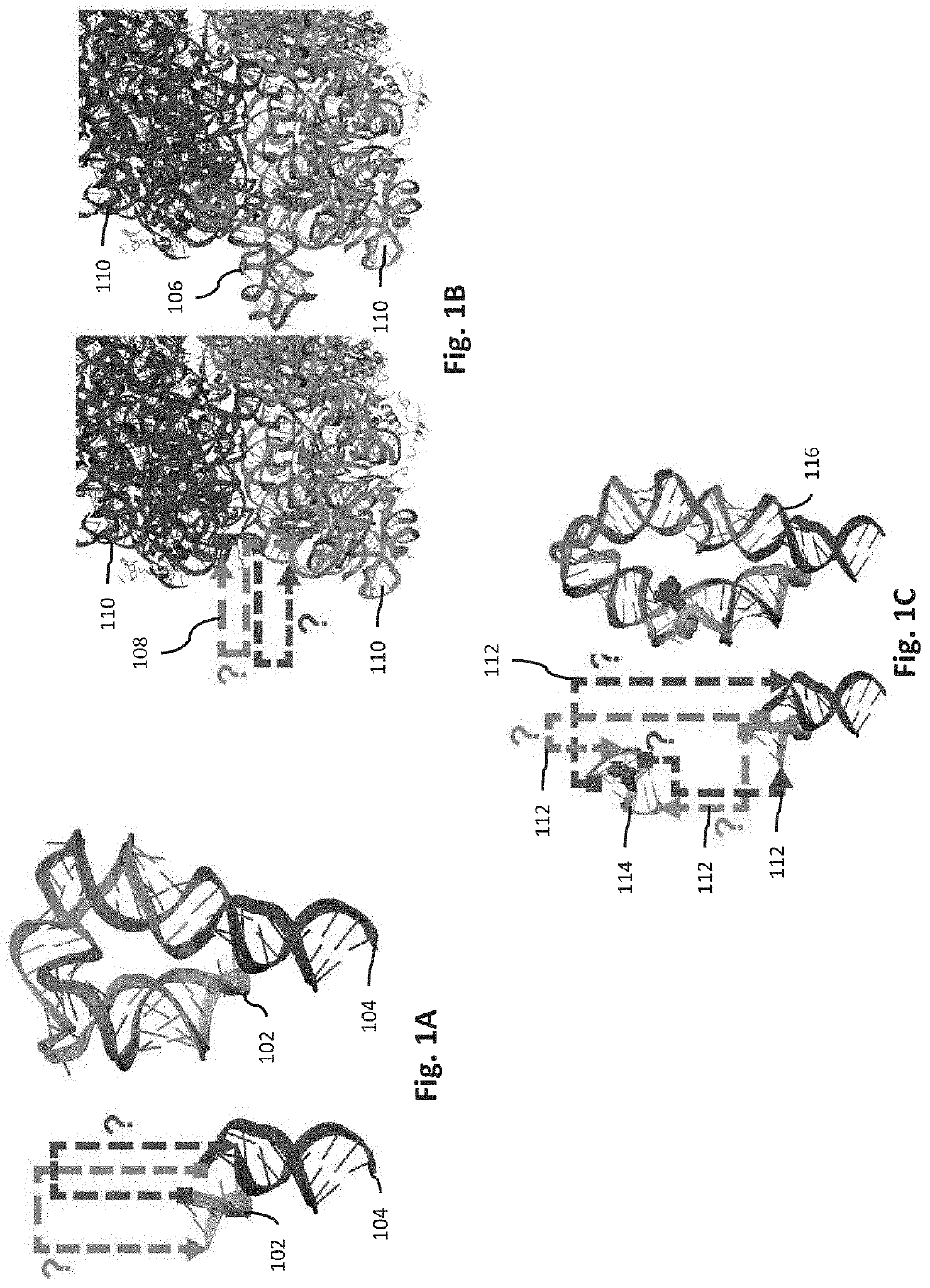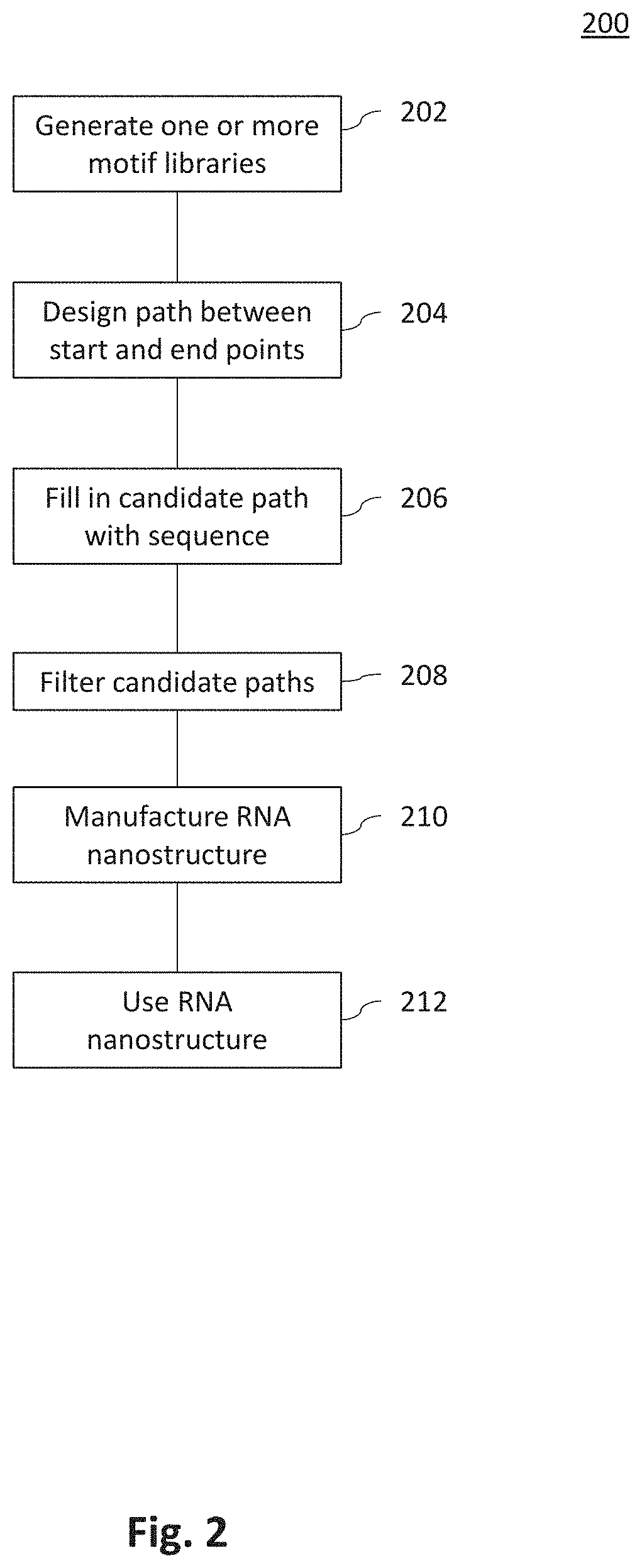Systems and Methods for Designing RNA Nanostructures and Uses Thereof
a technology of aptamer and nanostructure, which is applied in the field of ribonucleic acid (rna) aptamer, can solve the problems of aptamer selection suffering, field is far from generating rna, and limited selection experiments
- Summary
- Abstract
- Description
- Claims
- Application Information
AI Technical Summary
Benefits of technology
Problems solved by technology
Method used
Image
Examples
example 1
Building RNA Nanostructures
[0101]Methods: To build a curated motif library of all RNA structural components, a set of non-redundant RNA crystal structures managed by the Leontis and Zirbel groups (version 1.45: rna.bgsu.edu / rna3dhub / nrlist / release / 1.45) were obtained. (See Petrov, A. I., et al. (2013) Automated classification of RNA 3D motifs and the RNA 3D Motif Atlas. RNA 19, 1327-1340; the disclosure of which is incorporated herein by reference in its entirety.) This set specifically removes redundant RNA structures that are identical to previously solved structures, such as ribosomes crystallized with different antibiotics. Each RNA structure to extract every motif with Dissecting the Spatial Structure of RNA (DSSR); (see Lu, X.-J., et al. (2015) DSSR: an integrated software tool for dissecting the spatial structure of RNA. Nucleic Acids Res. 43, e142; the disclosure of which is incorporated herein by reference in its entirety;) were processed with the following command:
x3dna-ds...
example 2
Design, Synthesis and Experimental Testing of TTR Linking Constructs
[0114]Background: The problem of creating a well-folded RNA nanostructure was first solved two decades ago by repurposing the well-characterized tetraloop / receptor (TTR) tertiary contact to bring together two separate RNA chains, analogous to the P4-P6 domain of the Tetrahymena group I self-splicing intron and other natural functional RNAs. While later RNA nanotechnology studies used the TTR module and other structural motifs to design different nanostructures, the resulting RNAs original and later designs have all been multi-chain assemblies. (See Bindewald, E., et al. (2008) Computational strategies for the automated design of RNA nanoscale structures from building blocks using NanoTiler. J Mol Graph Model 27, 299-308; Dibrov, S. M., et al. (2011) Self-assembling RNA square. Proc. Natl. Acad. Sci. USA 108, 6405-6408; Afonin, K. A., et al. (2014) Multifunctional RNA nanoparticles. Nano Lett. 14, 5662-5671; Khisamut...
example 3
Automated 3D Design of Covalently Tethered Ribosomal Subunits
[0126]Background: The ribosome is a ribonucleoprotein machine dominated by two extensive RNA subunits, the 16S and 23S rRNAs. Previous work constructed a tethered ribosome called Ribo-T, in which the large and small subunit rRNAs were connected by an RNA tether to form a single subunit ribosome. In that work, the major bottleneck involved a year of numerous trial-and-error iterations to identify RNA tethers that were not cleaved by ribonucleases in vivo when wild type ribosomes were replaced in the Squires strain (SQ171fg) of E. coli. SQ171fg cells lack genetic rRNA alleles, surviving off plasmids that can be exchanged using positive and negative selections. Early failure rounds involving ribosomes from prior studies are shown in FIG. 12A-12B and success with Ribo-T in FIG. 12C. Nevertheless, the current tethers in Ribo-T are unstructured and unlikely to remain stable if other modules are incorporated (FIG. 12C). It is hyp...
PUM
| Property | Measurement | Unit |
|---|---|---|
| Length | aaaaa | aaaaa |
| Structure | aaaaa | aaaaa |
| Tertiary structure | aaaaa | aaaaa |
Abstract
Description
Claims
Application Information
 Login to View More
Login to View More - R&D
- Intellectual Property
- Life Sciences
- Materials
- Tech Scout
- Unparalleled Data Quality
- Higher Quality Content
- 60% Fewer Hallucinations
Browse by: Latest US Patents, China's latest patents, Technical Efficacy Thesaurus, Application Domain, Technology Topic, Popular Technical Reports.
© 2025 PatSnap. All rights reserved.Legal|Privacy policy|Modern Slavery Act Transparency Statement|Sitemap|About US| Contact US: help@patsnap.com



